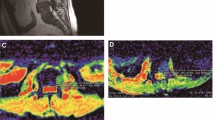Abstract
Purpose
The aim of this study was to assess the feasibility of using intravenously administered gadofosveset trisodium as a negative contrast agent for lymph node (LN) assessment with diffusion-weighted imaging (DWI) using a VX2 tumor model in rabbits.
Materials and methods
VX2 cells were injected in the right hind limb of five Japanese white rabbits to induce ipsilateral popliteal LN metastasis. DWI was performed before and every 7.5 min (until 1 h) after intravenous gadofosveset trisodium administration, at 1.5 T. Signal intensities (SIs) of right (metastatic) and left (nonmetastatic) popliteal LNs at each time point were measured and compared to each other using two-sided unpaired t-tests.
Results
The SIs of metastatic lymph nodes were significantly higher (P < 0.05) than those of nonmetastatic LNs at each time point after intravenous gadofosveset trisodium administration. Although the SI of metastatic LNs was significantly higher (P = 0.0237) than that of nonmetastatic LNs before contrast injection, this difference became even more significant (P ≤ 0.0105) after gadofosveset trisodium administration.
Conclusion
The SI of metastatic LNs at DWI is less suppressed than that of nonmetastatic LNs after the intravenous administration of gadofosveset trisodium. Therefore, intravenously administered gadofosveset trisodium shows promise for use as a negative contrast agent for discriminating metastatic from nonmetastatic LNs at DWI.
Similar content being viewed by others
References
Jemal A, Siegel R, Ward E, Hao Y, Xu J, Thun MJ. Cancer statistics, 2009. CA Cancer J Clin 2009;59:225–249.
Edge SB, Byrd DR, Compton CC, Fritz AG, Greene FL, Trotti A, editors. AJCC cancer staging manual. 7th edn. New York: Springer; 2010.
Guermazi A, Brice P, Hennequin C, Sarfati E. Lymphography: an old technique retains its usefulness. Radiographics 2003;23:1541–1558.
Torabi M, Aquino SL, Harisinghani MG. Current concepts in lymph node imaging. J Nucl Med 2004;45:1509–1518.
Padhani AR, Liu G, Koh DM, Chenevert TL, Thoeny HC, Takahara T, et al. Diffusion-weighted magnetic resonance imaging as a cancer biomarker: consensus and recommendations. Neoplasia 2009;11:102–125.
Takahara T, Imai Y, Yamashita T, Yasuda S, Nasu S, Van Cauteren M. Diffusion weighted whole body imaging with background body signal suppression (DWIBS): technical improvement using free breathing, STIR and high resolution 3D display. Radiat Med 2004;22:275–282.
De Bondt RB, Hoeberigs MC, Nelemans PJ, Deserno WM, Peutz-Kootstra C, Kremer B, et al. Diagnostic accuracy and additional value of diffusion-weighted imaging for discrimination of malignant cervical lymph nodes in head and neck squamous cell carcinoma. Neuroradiology 2009;51:183–192.
Vandecaveye V, De Keyzer F, Vander Poorten V, Dirix P, Verbeken E, Nuyts S, et al. Head and neck squamous cell carcinoma: value of diffusion-weighted MR imaging for nodal staging. Radiology 2009;251:134–146.
Nakayama J, Miyasaka K, Omatsu T, Onodera Y, Terae S, Matsuno Y, et al. Metastases in mediastinal and hilar lymph nodes in patients with non-small cell lung cancer: quantitative assessment with diffusion-weighted magnetic resonance imaging and apparent diffusion coefficient. J Comput Assist Tomogr 2010;34:1–8.
Sakurada A, Takahara T, Kwee TC, Yamashita T, Nasu S, Horie T, et al. Diagnostic performance of diffusion-weighted magnetic resonance imaging in esophageal cancer. Eur Radiol 2009;19:1461–1469.
Yasui O, Sato M, Kamada A. Diffusion-weighted imaging in the detection of lymph node metastasis in colorectal cancer. Tohoku J Exp Med 2009;218:177–183.
Kim JK, Kim KA, Park BW, Kim N, Cho KS. Feasibility of diffusion-weighted imaging in the differentiation of metastatic from non-metastatic lymph nodes: early experience. J Magn Reson Imaging 2008;28:714–719.
Park SO, Kim JK, Kim KA, Park BW, Kim N, Cho G, et al. Relative apparent diffusion coefficient: determination of reference site and validation of benefit for detecting metastatic lymph nodes in uterine cervical cancer. J Magn Reson Imaging 2009;29:383–390.
Eiber M, Beer AJ, Holzapfel K, Tauber R, Ganter C, Weirich G, et al. Preliminary results for characterization of pelvic lymph nodes in patients with prostate cancer by diffusion-weighted MR-imaging. Invest Radiol 2010;45:15–23.
Nakai G, Matsuki M, Inada Y, Tatsugami F, Tanikake M, Narabayashi I, et al. Detection and evaluation of pelvic lymph nodes in patients with gynecologic malignancies using body diffusion-weighted magnetic resonance imaging. J Comput Assist Tomogr 2008;32:764–768.
Lin G, Ho KC, Wang JJ, Ng KK, Wai YY, Chen YT, et al. Detection of lymph node metastasis in cervical and uterine cancers by diffusion-weighted magnetic resonance imaging at 3T. J Magn Reson Imaging 2008;28:128–135.
Roy C, Bierry G, Matau A, Bazille G, Pasquali R. Value of diffusion-weighted imaging to detect small malignant pelvic lymph nodes at 3 T. Eur Radiol 2010;20:1803–1811.
Goyen M, Shamsi K, Schoenberg SO. Vasovist-enhanced MR angiography. Eur Radiol 2006;16(suppl 2):B9–B14.
Herborn CU, Lauenstein TC, Vogt FM, Lauffer RB, Debatin JF, Ruehm SG. Interstitial MR lymphography with MS-325: characterization of normal and tumor-invaded lymph nodes in a rabbit model. AJR Am J Roentgenol 2002;179:1567–1572.
Lahaye MJ, Beets GL, Engelen SME, Voth M, Leiner T, Lambregts DMJ, et al. Gadovosfeset trisodium (Vasovist?) enhanced MR lymphnode detection: initial observations. Open Magn Reson J 2009;2:28–32.
Herman PG, Kim CS, de Sousa MA, Mellins HZ. Microcirculation of the lymph node with metastases. Am J Pathol 1976;85:333–348.
Fischbein NJ, Noworolski SM, Henry RG, Kaplan MJ, Dillon WP, Nelson SJ. Assessment of metastatic cervical adenopathy using dynamic contrast-enhanced MR imaging. AJNR Am J Neuroradiol 2003;24:301–311.
Milosevic MF, Fyles AW, Hill RP. The relationship between elevated interstitial fluid pressure and blood flow in tumors: a bioengineering analysis. Int J Radiat Oncol Biol Phys 1999;43:1111–1123.
Author information
Authors and Affiliations
Corresponding author
About this article
Cite this article
Yamashita, T., Takahara, T., Kwee, T.C. et al. Diffusion magnetic resonance imaging with gadofosveset trisodium as a negative contrast agent for lymph node metastases assessment. Jpn J Radiol 29, 25–32 (2011). https://doi.org/10.1007/s11604-010-0513-2
Received:
Accepted:
Published:
Issue Date:
DOI: https://doi.org/10.1007/s11604-010-0513-2




